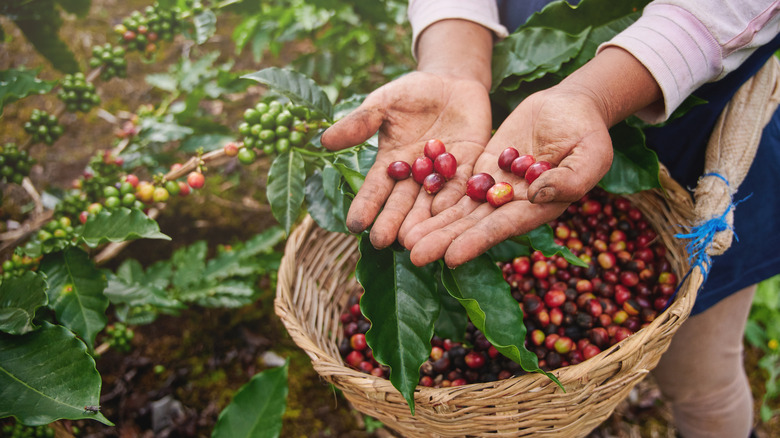Are Coffee Beans Actually Beans?
Coffee consumption is on the rise in the U.S., with 66% of Americans partaking of it on a daily basis, per Bloomberg. This is happening even as inflation drives food prices skyward around the country, thanks to the growing popularity of home-brewing. But despite the drink's nationwide popularity, few Americans would be likely to recognize coffee in the wild. That is due in part to the fact that coffee plants aren't grown commercially anywhere in the continental U.S.
According to the National Coffee Association, all commercially-sold coffee is grown in a region known as the Coffee Belt, in the equatorial zone between latitudes 30 degrees south and 25 degrees north. The only U.S. state that falls within this region is Hawaii, which is famous for its Kona coffee, but the biggest producers of coffee by far are Brazil and Colombia. Their hot and wet climates are ideal for growing coffee cherries — that's right, cherries, not beans.
Coffee beans are the seeds of coffee cherries
Your morning brew begins with Coffea, a genus of plants that encompasses thousands of species, about 25 to 100 of which can be grown for coffee (via the National Coffee Association). However, the commercial space is dominated by two coffee species — Arabica and Robusta. Coffee trees can grow up to 30 feet tall, but are typically kept short in agricultural settings to reduce the plant's energy needs and make harvesting easier. What we call "coffee beans" are actually the seeds of the bright red berries that sprout along the branches, known as "coffee cherries."
Coffee cherries look quite similar to regular red cherries, but the resemblance is only superficial. The cherry has an outer skin called the exocarp, beneath which is a thin layer of pulp called the mesocarp and a layer of slime known as the parenchyma. Under the slime lie the two coffee beans, wrapped in a thin membrane. Traditionally, farmers dry the whole fruit for seven to 10 days after harvesting, and the seeds (beans) are not removed until the very end of the process, per HowStuffWorks. After they have been separated, it's time to roast the coffee beans, either light or dark, to fine-tune their flavor and caffeine content.

